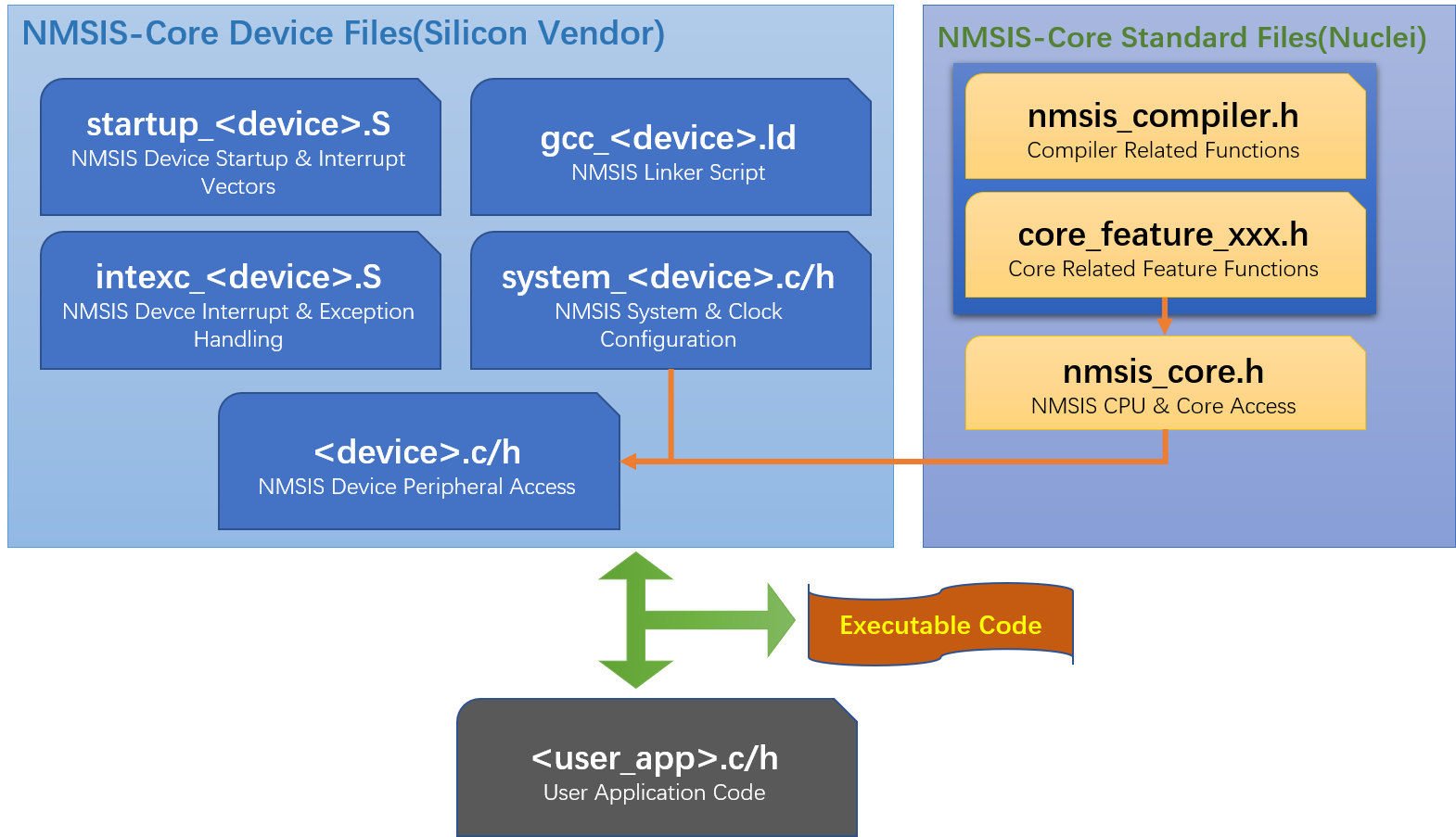NMSIS-Core Device Templates
Introduction
Caution
Please be informed that the NMSIS-Core Device Templates may not be updated in a timely manner and thus could become outdated. We suggest referring to the specific implementation of evalsoc in the Nuclei SDK for the latest reference template. This reference template may not be actively maintained in the future.
Nuclei supplies NMSIS-Core device template files for the all supported Nuclei N/NX/UX Class Processors and various compiler vendors. Refer to the list of supported toolchain for compliance.
- These NMSIS-Core device template files include the following:
Register names of the Core Peripherals and names of the Core Exception/Interrupt Vectors.
Functions to access core peripherals, special CPU instructions and SIMD instructions
Generic startup code and system configuration code.
The detailed file structure of the NMSIS-Core device templates is shown in the following picture.

NMSIS-Core Device Templates
Nuclei SDK is an open source Nuclei RISC-V processor software development kit which is based on NMSIS project, using NMSIS Core/DSP/NN header files and prebuilt NMSIS DSP/NN library, and also create Nuclei FPGA evaluation SoC called evalsoc support package based on NMSIS device template, if you want to know how to use NMSIS, it is a good startup.
NMSIS-Core Processor Files
The NMSIS-Core processor files provided by Nuclei are in the directory NMSIS/Core/Include.
These header files define all processor specific attributes do not need any modifications.
The nmsis_core.h defines the core peripherals and provides helper functions that access the core registers.
Device Examples
The NMSIS Software Pack defines several devices that are based on the Nuclei N/NX/U/UX processors.
The device related NMSIS-Core files are in the directory Device/Nuclei, but it is removed
since NMSIS 1.2.0 release, and please directly refer to the Template Files or Nuclei SDK project’s SoC/evalsoc
support code.
Template Files
To simplify the creation of NMSIS-Core device files, the following template files are provided that should be extended by the silicon vendor to reflect the actual device and device peripherals.
- Silicon vendors add to these template files the following information:
Device Peripheral Access Layer that provides definitions for device-specific peripherals.
Access Functions for Peripherals (optional) that provides additional helper functions to access device-specific peripherals.
Interrupt vectors in the startup file that are device specific.
Template File (Under ./Device/_Template_Vendor/Vendor/) |
Description |
Device/Source/GCC/startup_Device.S |
Startup file template for GCC/Clang RISC-V Embedded Compiler. |
Device/Source/GCC/gcc_Device.ld |
Link Script file template for GCC/Clang RISC-V Embedded Compiler. |
Device/Source/GCC/intexc_Device.S |
Exception and Interrupt handling file template(machine mode) for GCC/Clang RISC-V Embedded Compiler. |
Device/Source/GCC/intexc_Device_s.S |
Exception and Interrupt handling file template(supervisor mode) for GCC/Clang RISC-V Embedded Compiler. |
Device/Source/IAR/startup_Device.c |
Startup file template for IAR RISC-V Compiler. |
Device/Source/IAR/iar_Device.icf |
Link Script file template for IAR RISC-V Compiler. |
Device/Source/IAR/intexc_Device.S |
Exception and Interrupt handling file template(machine mode) for IAR RISC-V Compiler. |
Device/Source/IAR/intexc_Device_s.S |
Exception and Interrupt handling file template(supervisor mode) for IAR RISC-V Compiler. |
Device/Source/system_Device.c |
Generic system_Device.c file for system configuration (i.e. processor clock and memory bus system). |
Device/Include/Device.h |
Generic device header file. Needs to be extended with the device-specific peripheral registers. Optionally functions that access the peripherals can be part of that file. |
Device/Include/system_Device.h |
Generic system device configuration include file. |
Note
The template files for silicon vendors are placed under ./Device/_Template_Vendor/Vendor/.
Please goto that folder to find the file list in the above table.
Adapt Template Files to a Device
The following steps describe how to adopt the template files to a specific device or device family.
- Copy the complete all files in the template directory and replace:
directory name
Vendorwith the abbreviation for the device vendor e.g.: GD.directory name
Devicewith the specific device name e.g.: GD32VF103.in the file names
Devicewith the specific device name e.g.: GD32VF103.
Each template file contains comments that start with TODO: that describe a required modification.
The template files contain place holders:
Placeholder |
Replaced with |
<Device> |
the specific device name or device family name; i.e. GD32VF103. |
<DeviceInterrupt> |
a specific interrupt name of the device; i.e. TIM1 for Timer 1. |
<DeviceAbbreviation> |
short name or abbreviation of the device family; i.e. GD32VF. |
Nuclei-N# |
the specific Nuclei Class name; i.e. Nuclei N or Nuclei NX. |
Device Templates Explaination
Caution
The template files and its explaination maybe out of date, please directly take evalsoc in the Nuclei SDK support source code as reference device templates and read the source code and comment inside it.
The device configuration of the template files is described in detail on the following pages:
We only explain machine mode intexc_Device.S template, its supervisor mode version is similar,
please directly check the code, and for the IAR device templates, the flow is also similar, but
it reused startup code provided in IAR compiler, and implement Nuclei dependent boot code in
__low_level_init function.